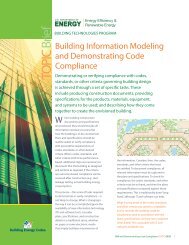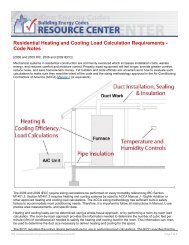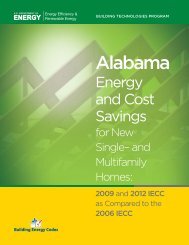Shaping the Energy Efficiency in New Buildings - Building Energy ...
Shaping the Energy Efficiency in New Buildings - Building Energy ...
Shaping the Energy Efficiency in New Buildings - Building Energy ...
Create successful ePaper yourself
Turn your PDF publications into a flip-book with our unique Google optimized e-Paper software.
Canada and India adopt compliance paths similar to that of <strong>the</strong> United States <strong>in</strong>clud<strong>in</strong>goptions of simpler trade-offs and build<strong>in</strong>g performance standards. Each major section(such as build<strong>in</strong>g envelope, HVAC, hot water service, light<strong>in</strong>g, and electric power)conta<strong>in</strong>s mandatory provisions followed by ei<strong>the</strong>r prescriptive provisions or a build<strong>in</strong>gperformance approach, which often leads to a separate section. A trade-off approach is<strong>in</strong>troduced <strong>in</strong> <strong>the</strong> section on build<strong>in</strong>g envelope. Some differences <strong>in</strong> build<strong>in</strong>g energycodes of <strong>the</strong>se three countries <strong>in</strong>clude <strong>the</strong> follow<strong>in</strong>g:Canada. The section on build<strong>in</strong>g energy performance compliance lists <strong>the</strong>conditions and limitations of apply<strong>in</strong>g <strong>the</strong> build<strong>in</strong>g performance approach andrefers to two o<strong>the</strong>r complementary documents for details of calculationprocedures. In <strong>the</strong> section on build<strong>in</strong>g envelope, two trade-off approaches–simpletrade-offs and computer-assisted trade-offs–are alternative options to prescriptiveprovisions. India. An ECBC appendix titled Whole Build<strong>in</strong>g Performance Method providesdetails on model<strong>in</strong>g requirements for calculat<strong>in</strong>g a reference and designedbuild<strong>in</strong>g. The build<strong>in</strong>g trade-off calculation method for <strong>the</strong> envelope performancefactor is <strong>in</strong>troduced <strong>in</strong> ano<strong>the</strong>r appendix. The build<strong>in</strong>g performance approach <strong>in</strong> <strong>the</strong> United States’ ASHRAE 90.1-2007uses <strong>the</strong> energy/cost/budget method, which compares <strong>the</strong> annual energy costs of areference build<strong>in</strong>g and a design build<strong>in</strong>g. The cost-oriented build<strong>in</strong>g performanceapproach differs from o<strong>the</strong>r build<strong>in</strong>g performance approaches that often use<strong>in</strong>dicators of energy consumption for comparison. In <strong>the</strong> section on build<strong>in</strong>genvelope, a trade-off approach is <strong>in</strong>troduced and details on <strong>the</strong> calculation of <strong>the</strong>envelope performance factor appear <strong>in</strong> an appendix. In <strong>the</strong> HVAC section, asimplified approach 48 is an alternative to <strong>the</strong> mandatory provisions, prescriptiveprovisions, and <strong>the</strong> energy/cost/budget method. In <strong>the</strong> light<strong>in</strong>g section, <strong>the</strong>build<strong>in</strong>g area method and space-by-space method are two trade-off approachesoffered. The United States’ residential build<strong>in</strong>g energy code, IECC 2006, offerstwo alternative compliance approaches (<strong>in</strong> addition to <strong>the</strong> prescriptive path): <strong>the</strong>trade-off approach for <strong>the</strong> build<strong>in</strong>g envelope and a simulated performanceapproach for <strong>the</strong> whole house.3.9 RenovationsSome countries require any renovation or addition to meet <strong>the</strong> code, while o<strong>the</strong>rsestablish a threshold. If renovations are required to meet <strong>the</strong> code, <strong>the</strong>y must typicallymeet all relevant aspects of <strong>the</strong> code. For example, Canada’s codes specify thatrenovations of at least 10 square meters <strong>in</strong> build<strong>in</strong>gs and homes must meet <strong>the</strong> build<strong>in</strong>genergy code requirements. In <strong>the</strong> United States, ASHRAE 90.1-2007 considers anyaddition beyond <strong>the</strong> exist<strong>in</strong>g build<strong>in</strong>g envelope or alteration to an exist<strong>in</strong>g, regulatedbuild<strong>in</strong>g to fall under <strong>the</strong> code. IECC 2006 generally requires any additions, alterations,renovations or repairs to meet <strong>the</strong> code.48 The simplified approach is an optional path for build<strong>in</strong>gs of less than two stories (2323 m 2 or 25,000 ft 2 )and accord<strong>in</strong>g to where <strong>the</strong> HVAC system complies with certa<strong>in</strong> provisions listed <strong>in</strong> <strong>the</strong> HVAC section.56
















